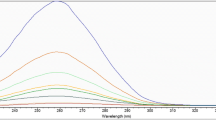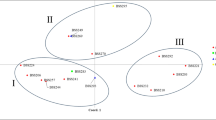Abstract
A species-specific DNA sequence (marker) that can detect the presence of Secale cereale chromatin in common wheat background was developed by using wheat microsatellite primer Xgwm614. One rye-specific DNA amplified fragment of 416bp (pSa614416) was obtained from Secale africanum and a wheat — S. africanum amphiploid. The primer Xgwm614 also gave rise to specific bands in all Chinese Spring-Imperial rye addition lines 1R to 7R. Sequence analysis revealed that pSa614416 was strongly homologous to a miniature inverted transposable element (MITE) stowaway-like element. Results of fluorescence in situ hybridization showed that the signal of pSa614416 was distributed along all S. cereale. cv Jingzhou chromosomes, but the signal strengths were unbalanced on the seven rye genome chromosomes. This repetitive element may be useful as a molecular marker for the introgression of rye germplasm into the wheat genome.
Similar content being viewed by others
References
Adonina I.G., Salina E. A., Efremova T.T. & Pshenichnikova T.A. 2004. The study of introgressive lines of Triticum aestivum — Aegilops speltoides by in situ and SSR analyses. Plant Breeding 123: 220–224.
Amrani A.E., Marie L., Ainouche A., Nicolas J. & Couee I. 2002. Genome-wide distribution and potential regulatory functions ofAt ATE, a novel family of miniature inverted-repeat transposable elements in Arabidopsis thaliana. Mol. Genet. Genomics 267: 459–471.
Belyayev A., Raskina O. & Nevo E. 2001. Detection of alien chromosomes from S-genome species in the addition/substitution lines of bread wheat and visualization of A-, Band D-genomes by GISH. Hereditas 135: 119–122.
Bureau T.E. & Wessler S.R. 1992. Tourist: a large family of small inverted repeat elements frequently associated with maize genes. Plant Cell 4: 1283–1294.
Bureau T.E. & Wessler S.R. 1994. Stowaway: A new family of inverted repeat elements associated with the genes of both monocotyledonous and dicotyledonous plants. Plant Cell 6: 907–916.
Casacuberta E., Casacuberta J.M., Puigdomenech P. & Monfort A. 1998. Presence of miniature inverted-repeat transposable elements (MITEs) in the genome of Arabidopsis thaliana: characterization of the Emigrant family of elements. Plant J. 16: 79–85
Cuadrado A. & Jouve N. 2002. Evolutionary trends of different repetitive DNA sequences during speciation in the genus Secale. J. Hered. 93: 339–345
Cuadrado A. & Schwarzacher T. 1998. The chromosomal organization of simple sequence repeats in wheat and rye genomes. Chromosoma 107: 587–594.
Frederiksen S. & Petersen G. 1998. A taxonomic revision of Secale (Triticeae, Poaceae). Nordic J. Bot. 18: 399–420.
Feschotte C., Jiang N. & Wessler S.R. 2002. Plant transposable elements: where genetic meets genomics. Nature Rev. Genet. 3: 329–341.
Feschotte C., Swamy L. & Wessler S.R. 2003. Genome-wide analysis of mariner-like transposable elements in rice reveals complex relationship withstowaway miniature inverted repeat transposable elements (MITEs). Genetics 163: 747–758.
Friebe B. & Kynast R.G. 1999. Transfer of wheat-rye translocation chromosomes conferring resistance to hessian fly from bread wheat into durum wheat. Crop Sci. 39: 1696–1701.
Friebe B., Kynast R.G., Zhang P., Qi L., Dhar M. & Gill B.S. 2001. Chromosome healing by addition of telomeric repeats in wheat occur during the first mitotic divisions of the sporophyte and is a gradual process. Chromosome Res. 9: 137–146.
Fuchs J., Kohne M. & Schubert I. 1998. Assignment of linkage groups to pea chromosomes after karyotyping and gene mapping by fluorescent in situ hybridization. Chromosoma 107: 272–276.
Li W.L., Zhang P., Fellers J.P., Friebe B. & Gill B.S. 2004. Sequence composition, organization, and evolution of the core Triticeae genome. Plant J. 40: 500–511.
Liu C., Yang Z.J., Feng J., Zhou J.P., Chi S.H. & Ren Z.L. 2006. Development of Dasypyrum genome specific marker by using wheat microsatellites. Hereditas (Beijing) 28: 1573–1579.
Liu C., Yang Z.J., Li G.R., Zeng Z.X., Zhang Y., Zhou J.P., Liu Z.H. & Ren ZL. 2008. Isolation of a new repetitive DNA sequence from Secale africanum enables targeting of Secale chromatin in wheat background. Euphytica 159: 249–258.
Lukaszewski A.J. & Gustafson J.P. 1987. Cytogenetics of triticale. In: Janick J. (ed.), Plant Breeding Reviews 5: 41–93.
Macas J., Koblíková A. & Neumann P. 2005. Characterization of Stowaway MITEs in pea (Pisum sativum L.) and identification of their potential master elements. Genome 48: 831–839.
Mukai Y., Nakahara Y. & Yamamoto M. 1993. Simultaneous discrimination of the three genomes in hexaploid wheat by multicolor fluorescence in situ hybridization using total genomic and highly repeated DNA probes. Genome 36: 489–494.
Mullan R.J., Platteter A., Teakle N.L., Appels R., Colmer T.D., Anderson J.M. & Francki M.G. 2005. EST-derived SSR markers from defined regions of the wheat genome to identify Lophopyrum elongatum specific loci. Genome 48: 811–822.
Nagaki K., Tsujimoto H. & Sasakuma T. 1999. A novel repetitive sequence, termed the JNK repeat family, located on an extra heterochromatic region of chromosome 2R of Japanese rye. Chromosome Res. 7: 95–101.
Pestsova E. 2000. Microsatellite analysis of Aegilops tauschii germplasm. Theor. Appl. Genet. 101: 100–106.
Petersen G. & Seberg O. 2000. Phylogenetic evidence for excision of stowaway miniature inverted-repeat transposable elements in Triticeae (Poaceae). Mol. Biol. Evol. 17: 1589–1596.
Rogowsky P.M., Liu J.Y., Manning S., Taylor C. & Langridge P. 1992. Structural heterogeneity in the R173 family of ryespecific repetitive DNA sequences. Plant Mol. Biol. 20: 95–102.
Saito M., Yonemaru J., Ishikawa G. & Nakamura T. 2005. A candidate autonomous version of the wheat MITE Hikkoshi is present in the rice genome. Mol. Gen. Genomics 273: 404–414.
Sambrook J., Frisch E.F. & Maniatis J. 1989. Molecular cloning: a laboratory manual, 2nd ed. Cold Spring Harbor Laboratory Press.
Schmidt T. & Heslop-Harrison J.S. 1996. The physical and genomic organization of microsatellites in sugar beet. Proc. Natl. Acad. Sci. USA 93: 8761–8765.
Tautz D. & Renz M. 1984. Simple sequences are ubiquitous repetitive components of eukaryotic genomes. Nucleic Acids Res. 12: 4127–4138.
Tu Z. 2000. Molecular and evolutionary analysis of two divergent subfamilies of a novel miniature inverted repeat transposable elements in yellow fever mosquito, Aedes aegypti. Mol. Biol. Evol. 17: 1313–1325
Tu Z. 2001. Eight novel families of miniature inverted repeat transposable elements in African malaria mosquito, Anopheles gambiae. Genetics 98: 1699–1704.
Wessler S.R., Bureau T.E. & White S.E. 1995. LTR-retrotransoposons and MITEs: important players in the evolution of plant genomes. Curr. Opin. Genet. Dev. 5: 814–821.
Yang Z.J., Liu C., Feng J., Li G.R., Zhou J.P., Deng K.J. & Ren Z.L. 2006. Studies on genome relationship and speciesspecific PCR marker for Dasypyrum breviaristatum in Triticeae. Hereditas 143: 47–54.
Zhang X., Jiang N., Feschotte C. & Wessler S.R. 2004. PIFand Pong-Like transposable elements: distribution, evolution and relationship with Tourist-like miniature inverted-repeat transposable elements. Genetics 166: 971–986.
Zhou J., Yang Z., Li G., Liu C., Tang Z., Zhang Y. & Ren Z. 2010. Diversified chromosomal distribution of the tandem repeated sequences reveal evolutionary trends in Secale (Poaceae). Plant Syst. Evol. 287: 49–56.
Author information
Authors and Affiliations
Corresponding author
Rights and permissions
About this article
Cite this article
Hu, L., Zeng, Z., Liu, C. et al. Isolation and chromosomal localization of new MITE-like sequences from Secale . Biologia 67, 126–131 (2012). https://doi.org/10.2478/s11756-011-0139-6
Received:
Accepted:
Published:
Issue Date:
DOI: https://doi.org/10.2478/s11756-011-0139-6




